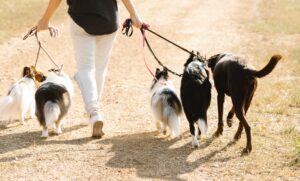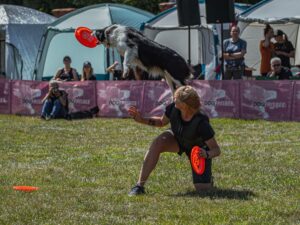Optimize Your Dog’s Exercise Routine: Mobile Dog Gyms & How They Help
As a loving pet parent, it’s your responsibility to ensure your furry friend gets enough physical exercise, much like humans. Failing to provide adequate exercise may result in your dog becoming overweight, frustrated, or bored, leading to undesirable behaviors. However, every dog has unique exercise requirements, influenced by factors like breed, size, age, and overall health. Understanding the signs that indicate your dog isn’t getting enough exercise is crucial to prevent complications. In this article, we’ll discuss nine (9) common signs and offer tips on getting your dog moving. Moreover, we’ll delve into the benefits of a mobile dog gym and how it can address various exercise-related issues.
Signs Your Dog Needs More Exercise
Weight Gain
Weight gain is often the first sign that your pet needs more exercise. Dr. Deborah Linder, head of Tufts Obesity Clinic for Animals, states that weight gain is partly due to low activity levels and calorie intake. Collaborating with your vet to develop a diet and exercise plan is vital to help your pet lose weight. A food journal detailing all the food, treats, table scraps, and chews given to your pet can aid your vet in creating an appropriate plan.

Extra weight on your pet can lead to several health problems, such as joint issues, diabetes, and heart disease. To prevent these complications, it is crucial to monitor your pet’s weight regularly and adjust their diet and exercise routine as needed. You can help your pet lose weight by incorporating more physical activities, like daily walks, swimming, or playing fetch, and providing them with a balanced diet with appropriate portion sizes.
Destructive Behavior
Destructive behaviors like chewing on shoes, furniture, or eliminating indoors may indicate that your pet needs more exercise. According to Linder, pets may act out behaviorally if they lack a positive energy outlet, like walking or running. Increasing your pet’s exercise can help reduce these undesirable behaviors.
When addressing destructive behavior, it’s important to consider both physical and mental stimulation. Mental exercises, such as puzzle toys, scent work, or obedience training, can help keep your pet’s mind sharp and engaged. Providing a well-rounded exercise routine that includes both physical and mental activities will ensure that your pet stays happy, healthy, and well-behaved.
Withdrawn Behavior
If your pet seems withdrawn or depressed, they might not be getting enough physical or mental stimulation. Scheduling a vet appointment is crucial to determining the underlying cause and helping your pet return to their normal self. Dr. Katie Grzyb of One Love Animal Hospital explains that hypothyroidism may cause withdrawn behavior and weight gain in some dogs, which can be diagnosed through blood testing.
In addition to medical issues, a lack of socialization, anxiety, or changes in the environment could contribute to withdrawn behavior in pets. Providing your pet with opportunities for social interaction, like playdates with other dogs, trips to the dog park, or group training classes, can help improve their mood and overall well-being.
Hyperactivity
On the other hand, if your dog is hyperactive or difficult to control on walks, they might require more exercise. Dr. Neala Boyer, a clinical assistant professor at Kansas State University, notes that dogs are more hyperactive when they’re not used to regular exercise. Rewarding your dog for paying attention and walking nicely beside you can help improve their leash manners.
Incorporating activities that require bursts of energy, like agility training, can help tire out a hyperactive dog. Additionally, engaging in structured playtime or enrolling your dog in a doggy daycare program can provide them with an appropriate outlet for their energy.
Stiffness or Low Stamina
Stiffness, low stamina, or symptoms like immobility and reluctance to go up and down stairs might signal a need for more exercise. Working with your vet to identify the underlying cause and developing a plan to increase activity levels is essential.
In some cases, stiffness or low stamina might be due to age, arthritis, or other health issues. Introducing low-impact exercises, like swimming or walking on soft surfaces, can help alleviate discomfort and maintain your pet’s mobility. It’s crucial to consult your vet before starting any new exercise routine to ensure it is suitable for your pet’s specific needs.
Eager Behavior
Barking, whining, or running towards the door are signs that your pet is eager for more physical activity. This eager behavior may indicate that your pet is not receiving enough exercise to meet their needs, which could lead to pent-up energy and potential destructive behaviors.
To address this issue, create a consistent exercise routine for your pet, taking into consideration their age, breed, and health status. Gradually increase the duration and intensity of their workouts to help them build endurance and maintain a healthy weight. Some activities to consider include hiking, jogging, or participating in dog sports such as flyball or disc dog.
Remember to always monitor your pet’s behavior and energy levels to ensure they are receiving an appropriate amount of exercise. Regular check-ups with your veterinarian are also crucial to keeping your pet in optimal health and catching any potential health issues early on.
In conclusion, understanding the signs of insufficient exercise and working with your vet to develop an appropriate exercise plan is essential for your pet’s overall well-being. By providing a well-rounded exercise routine that includes physical and mental stimulation, you can ensure your furry friend stays healthy, happy, and well-behaved.
Sleep Disturbances
One common sign that your dog may not be getting enough exercise is irregular sleep patterns or disturbances. A dog who is not sufficiently tired from physical activity may have difficulty settling down for sleep or staying asleep throughout the night. Restless sleep can contribute to a range of health issues, including weakened immune function and chronic stress.
To improve your dog’s sleep patterns, establish a consistent daily exercise routine that includes a mix of both physical and mental activities. Consider varying the types of exercise to keep your dog engaged and challenged. Some ideas include brisk walks or jogs, interactive play with toys, and mentally stimulating puzzle games. Always monitor your dog’s energy levels and make adjustments to their routine as needed. Additionally, establish a consistent bedtime routine to help signal to your dog that it’s time to wind down and sleep.
Excessive Panting or Fatigue
Excessive panting, fatigue, or slow recovery after physical activity could be another sign that your dog is not getting enough exercise. A lack of regular exercise can lead to decreased cardiovascular fitness and muscle strength, which can negatively impact your dog’s overall health and well-being.
To address this issue, work with your veterinarian to develop an appropriate exercise plan tailored to your dog’s specific needs. Start with low-impact exercises, such as swimming or gentle walks, and gradually increase the intensity and duration of their workouts. Focus on building your dog’s stamina and endurance over time, while also monitoring their heart rate and breathing during exercise. Be sure to provide plenty of fresh water and rest breaks, especially during hot weather or if your dog is overweight or elderly.
Anxiety and Stress
Anxiety and stress in dogs can manifest in various ways, such as excessive barking, whining, pacing, or even destructive behavior. One potential cause of anxiety and stress in dogs is insufficient exercise, leading to a buildup of nervous energy and tension.
To help reduce your dog’s anxiety and stress levels, incorporate regular exercise into their daily routine. Exercise has been shown to increase the production of endorphins, which are natural mood-boosting chemicals that can help alleviate anxiety and promote relaxation. In addition to physical exercise, provide mental stimulation for your dog through activities like scent work, puzzle toys, and obedience training. Socializing with other dogs can also help reduce anxiety by allowing your pet to expend energy through play and interaction.
When implementing a new exercise routine for your anxious dog, it’s essential to start slowly and gradually increase the intensity and duration of the activities. Be patient and gentle with your dog during this process, providing positive reinforcement and encouragement to help build their confidence and reduce their stress levels. Consult with your veterinarian or a professional dog trainer for additional guidance and support in addressing your dog’s anxiety and stress through exercise.
Benefits of a Mobile Dog Gym
A mobile dog gym, like K9 Sprinter, can be an excellent solution for dogs struggling with hyperactivity and weight gain. It provides a safe space for dogs to exercise, play, and burn off excess energy. With various equipment and obstacles, dogs can engage in fun, challenging activities that help release pent-up energy and improve overall fitness.
Promoting Weight Loss
For dogs with weight issues, a mobile dog gym promotes weight loss and helps maintain a healthy weight. Regular exercise burns calories, builds muscle, and increases metabolism. A trained professional can provide customized exercise plans tailored to your dog’s individual needs and goals. Socialization and stimulation from a mobile dog gym can also help reduce stress and anxiety, which often lead to overeating and weight gain.
Mental Stimulation and Well-being
In addition to physical benefits, a mobile dog gym can help increase mental stimulation and improve overall well-being. Dogs thrive on mental stimulation, and a lack of it can lead to boredom and destructive behavior. A mobile dog gym offers a fun and engaging environment that challenges dogs’ minds and keeps them mentally stimulated. This can result in improved cognitive function, increased problem-solving skills, and a more positive outlook on life.
A Great Investment for Your Dog’s Health
Overall, a mobile dog gym can be a fantastic investment for dogs struggling with hyperactivity, weight gain, and mental stimulation. By providing a fun and challenging environment, dogs can receive the exercise and mental stimulation they need to live happy and healthy lives. With the guidance of a trained professional, owners can rest assured that their dogs are receiving the best possible care and attention, and that their individual needs are being met.
Physical exercise is essential for your dog’s physical and mental well-being. Knowing the signs of insufficient exercise and working with your vet to develop an appropriate exercise plan can help keep your furry friend healthy and happy. A mobile dog gym, like K9 Sprinter, offers a convenient and effective solution for addressing various exercise-related issues, ensuring that your beloved pet remains active, engaged, and content.
Don’t forget to check out K9 Sprinter’s blog for informative articles on topics like dog health, wellness, and training. Also, explore their Top Dog series to learn about some incredible canines and their accomplishments.
Remember to always consult with your veterinarian before starting any new exercise regimen for your dog, as they can provide valuable insight into your pet’s specific needs and limitations. By working together, you can create a well-rounded exercise plan that suits your dog’s unique requirements and helps them lead a more fulfilling, energetic life.
FAQs
Remember to always consult with your veterinarian before starting any new exercise regimen for your dog, as they can provide valuable insight into your pet’s specific needs and limitations. By working together, you can create a well-rounded exercise plan that suits your dog’s unique requirements and helps them lead a more fulfilling, energetic life.
Can lack of exercise affect my dog’s immune system?
Yes, insufficient exercise can weaken your dog’s immune system, making them more susceptible to illness and infections. Regular exercise helps improve circulation, which in turn boosts immune function.
How can I tell if my dog is getting enough exercise?
Your dog is likely getting enough exercise if they maintain a healthy weight, have good energy levels, and display a happy, relaxed demeanor. If you notice changes in their behavior or physical condition, consult your veterinarian for guidance.
How much exercise does my dog need based on their breed?
The amount of exercise needed varies by breed, with some breeds requiring more physical activity than others. Research your dog’s breed or consult your veterinarian to determine the appropriate amount of exercise for their specific needs.
How can a mobile dog gym contribute to my dog’s exercise routine?
A mobile dog gym offers a convenient and engaging way to help your dog meet their exercise needs. With a variety of equipment and obstacles, dogs can engage in fun and challenging activities that help release pent-up energy and improve overall fitness. Mobile dog gyms can also provide socialization opportunities and mental stimulation, making them an excellent addition to your dog’s exercise routine.
How can I help my dog socialize while exercising?
Organizing playdates with other dogs, joining dog walking groups, or participating in dog-friendly community events can provide opportunities for your dog to socialize while exercising. Socialization is essential for your dog’s overall mental health and can make exercise more enjoyable for both of you.
What are some low-impact exercises suitable for older dogs or those with joint issues?
Swimming, gentle walks, and range-of-motion exercises can be beneficial for older dogs or those with joint issues. Consult your veterinarian for specific recommendations based on your dog’s individual needs.
Should I warm up or cool down my dog before and after exercise?
Warming up your dog with a slow walk or gentle play can help reduce the risk of injury, while a cool-down period after exercise can help prevent muscle stiffness and soreness.
How can I make exercise more enjoyable for my dog?
Incorporating variety, such as new walking routes, games, or playmates, can make exercise more enjoyable for your dog. Additionally, positive reinforcement and praise can help motivate your dog during physical activities.
Is it safe to exercise my dog in extreme heat or cold?
Extreme temperatures can pose risks to your dog’s health during exercise. In hot weather, opt for early morning or evening walks, provide plenty of water, and watch for signs of overheating. In cold weather, protect your dog with appropriate clothing and avoid icy surfaces that could cause injury.
Can I exercise my dog off-leash?
Off-leash exercise can be beneficial for your dog, provided they have reliable recall skills, and you’re in a safe, designated area. Always be aware of local leash laws and be considerate of other dogs and people in the vicinity.
Sources
District Dogs. (n.d.). Creating and maintaining an exercise routine for your dog. Retrieved from https://districtdogs.com/creating-and-maintaining-an-exercise-routine-for-your-dog/
PetCoach. (n.d.). How to start an exercise routine with your dog. Retrieved from https://www.petcoach.co/article/how-to-start-an-exercise-routine-with-your-dog/
WebMD Pets. (n.d.). How to exercise with your dog. Retrieved from https://pets.webmd.com/dogs/how-to-exercise-with-your-dog
American Kennel Club. (n.d.). How to get fit with your dog. Retrieved from https://www.akc.org/expert-advice/health/how-to-get-fit-with-your-dog/
The Spruce Pets. (n.d.). Great ways to exercise with dogs. Retrieved from https://www.thesprucepets.com/great-ways-to-exercise-with-dogs-1117865




